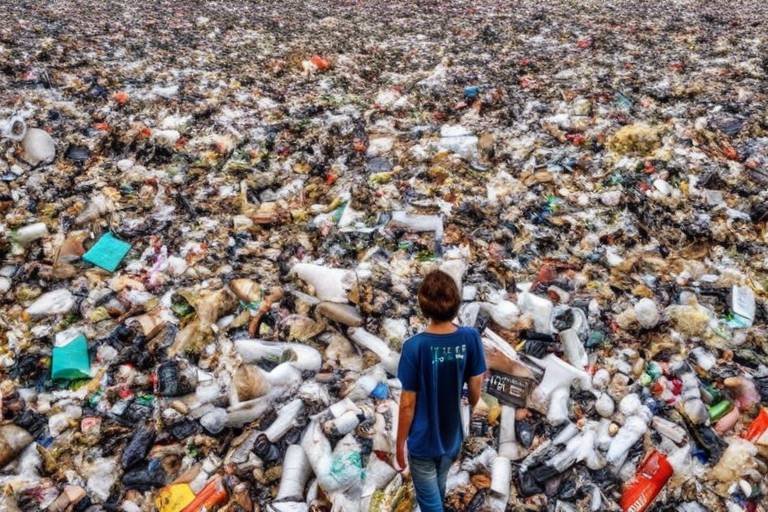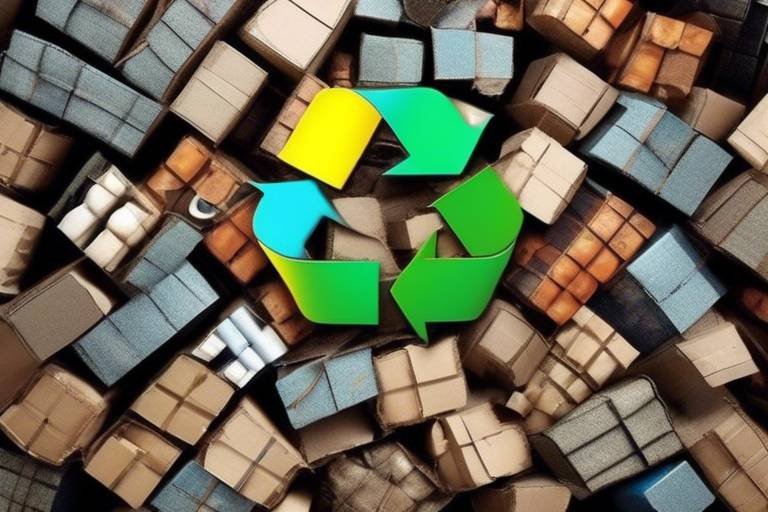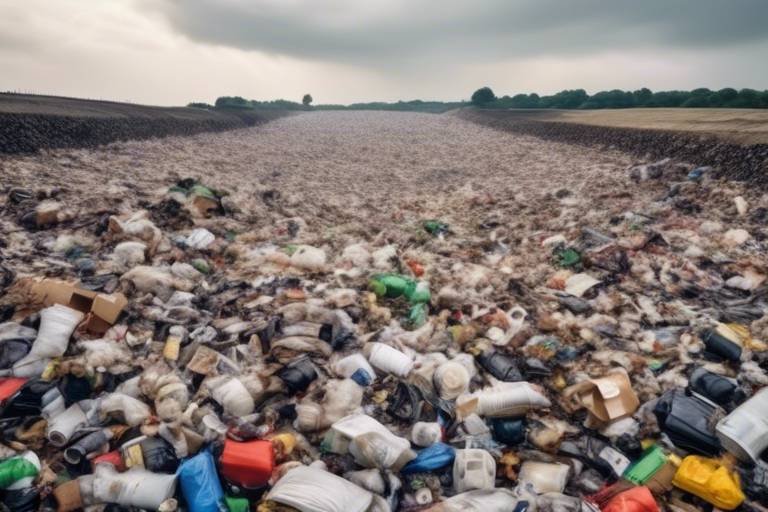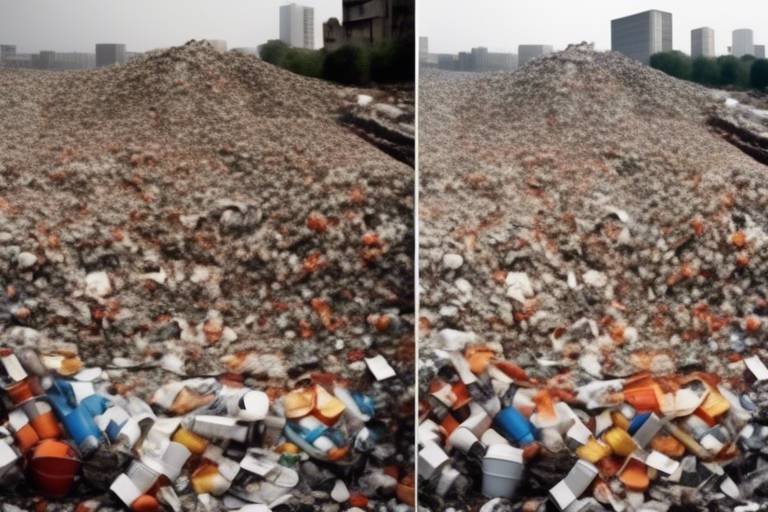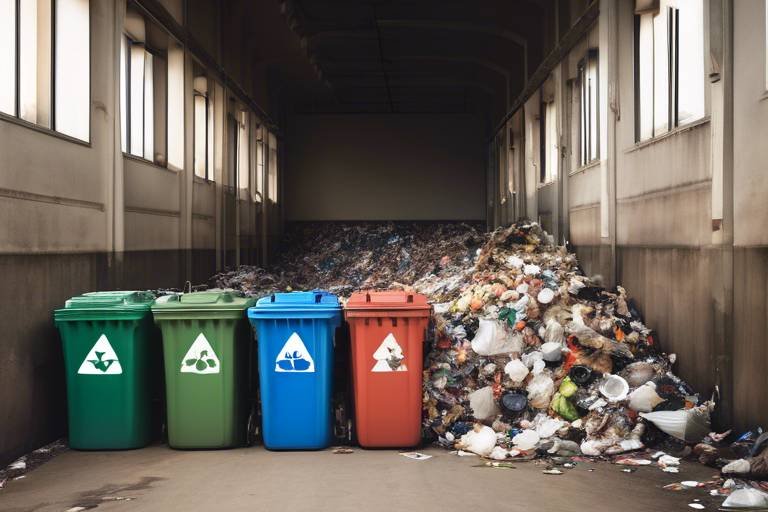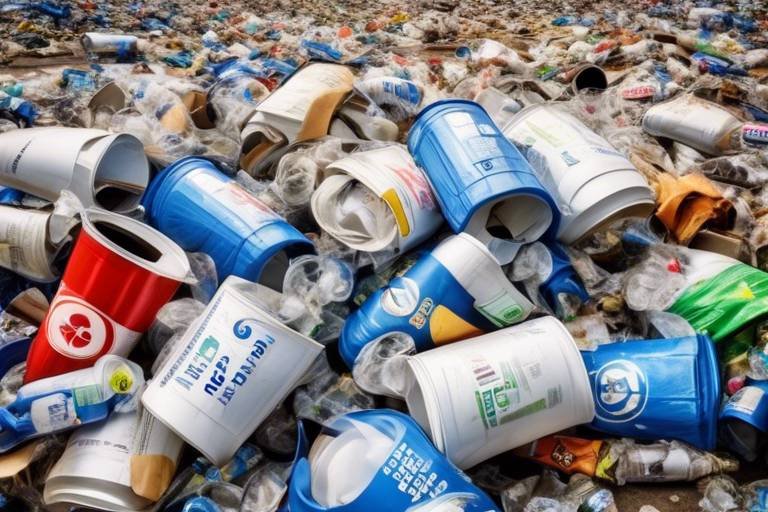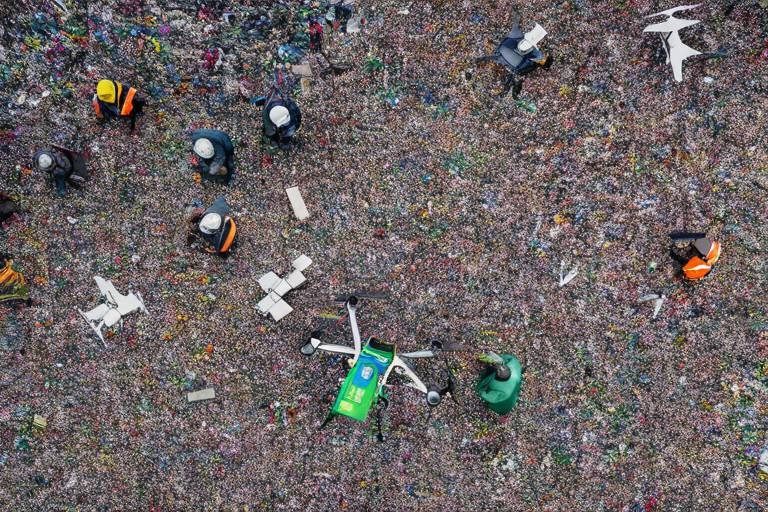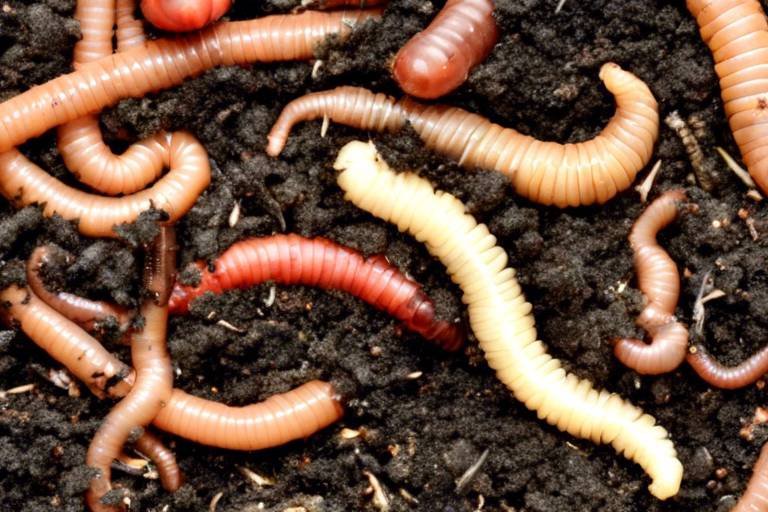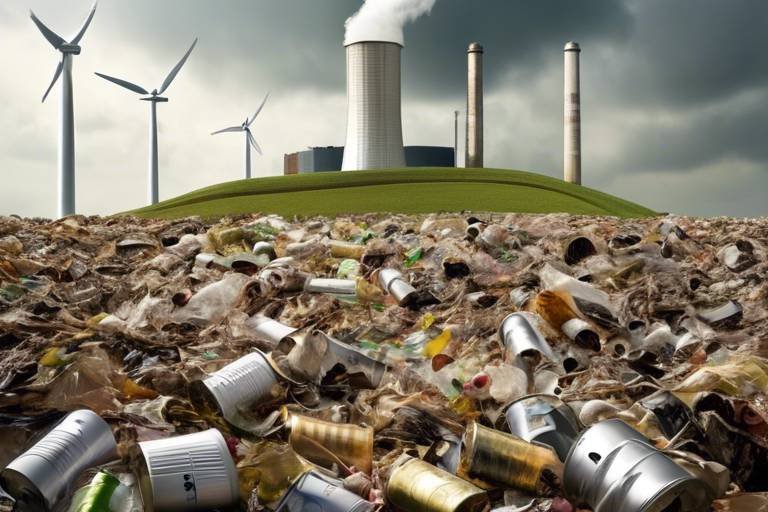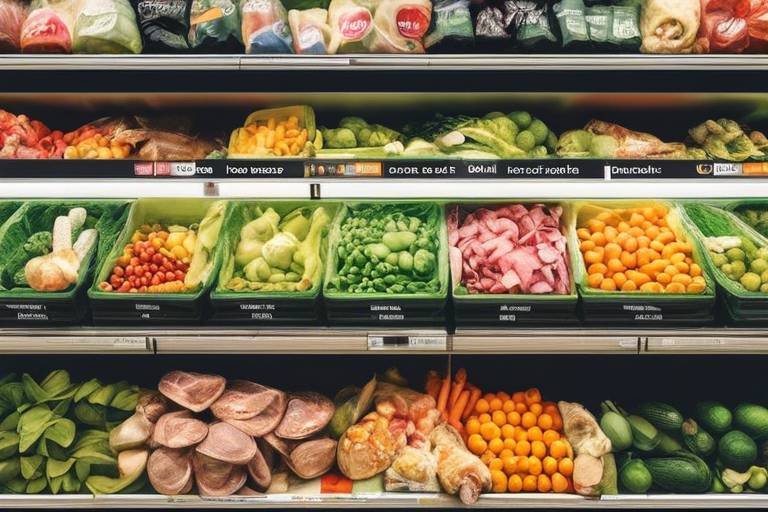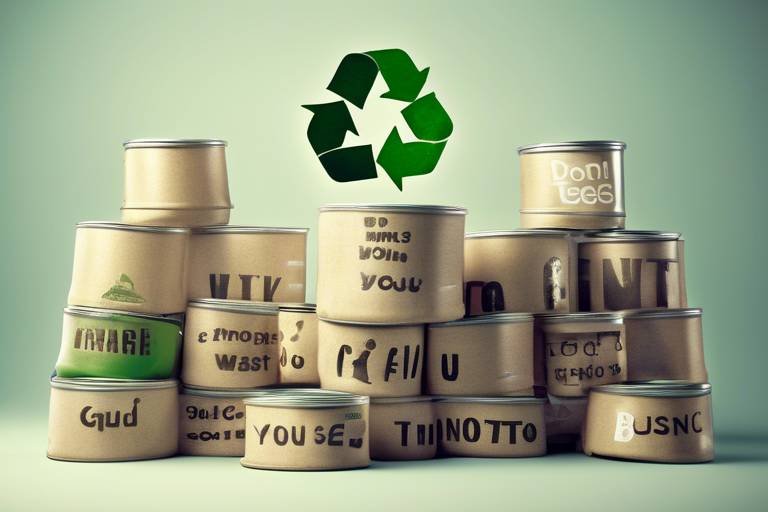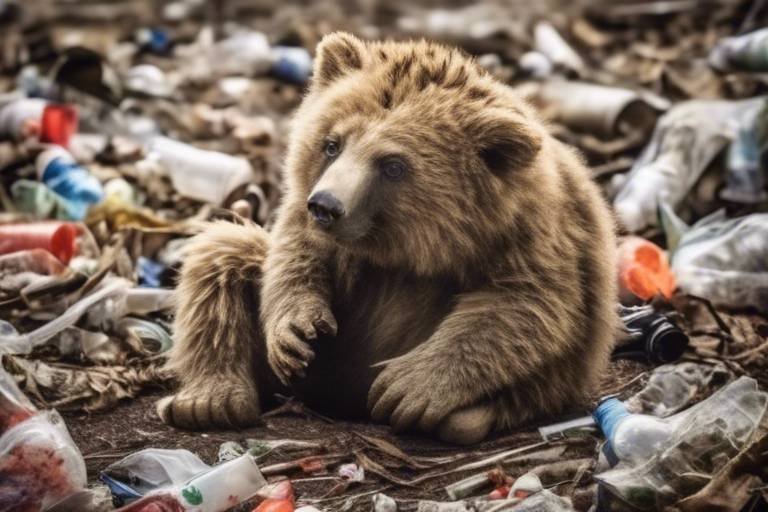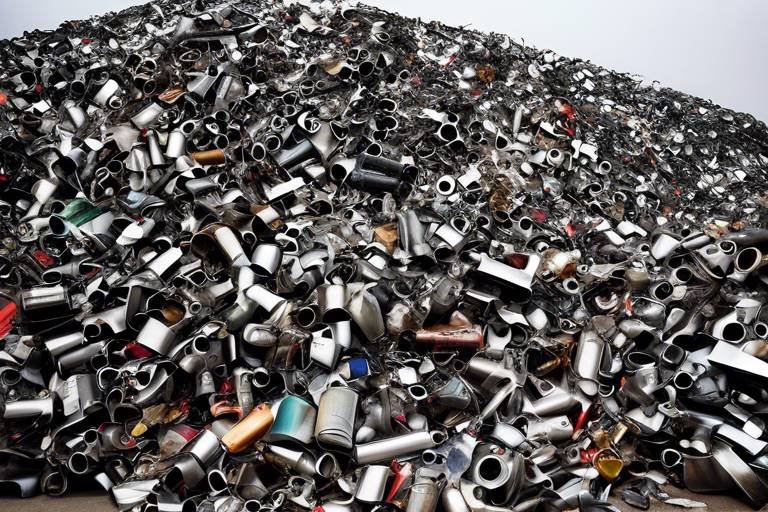The Impact of Consumerism on Waste Generation
Consumerism is often viewed as a driving force behind modern economies, but its impact on waste generation is a growing concern that cannot be overlooked. As we indulge in the never-ending cycle of buying and discarding, we inadvertently contribute to a significant environmental crisis. This article delves into how consumerism fuels waste generation, examining its effects not just on our planet, but also on our society and economy.
The concept of consumerism has evolved over decades, shaping our lifestyles and influencing our choices. It encourages us to acquire more goods and services than we truly need, often leading to a culture of disposability. Think about it: how many times have you purchased something only to use it once or twice before it ends up in the trash? This behavior is not just a personal choice; it's a societal norm that has deep roots in marketing and economic practices.
As we explore the intricate relationship between consumerism and waste, it becomes evident that our habits have dire consequences. The sheer volume of products we consume results in mountains of waste that our landfills struggle to accommodate. In fact, statistics reveal that the average American generates about 4.9 pounds of waste per day. This staggering figure highlights the urgency of addressing our consumption patterns before they spiral out of control.
One of the most alarming aspects of waste generation is the variety of materials involved. Different types of waste—ranging from plastic to electronic to food—pose unique challenges for waste management systems. Understanding these categories is essential for developing effective strategies to mitigate their impact. For instance, plastic waste, which is notorious for its non-biodegradable nature, can take hundreds of years to decompose, leading to severe environmental repercussions.
Moreover, the implications of waste generation extend beyond environmental concerns. Increased waste has significant societal effects, including health risks and economic costs. Communities burdened with excessive waste often face challenges such as pollution, which can lead to respiratory issues and other health problems. The economic costs of waste management can also strain local governments, diverting funds from essential services like education and healthcare.
In summary, the impact of consumerism on waste generation is a multifaceted issue that requires urgent attention. As we continue to navigate our consumer-driven society, it is crucial to recognize the consequences of our choices. By understanding the direct correlation between our habits and waste production, we can begin to explore sustainable practices that not only benefit the environment but also enhance our quality of life.
- What is consumerism? Consumerism is a social and economic order that promotes the acquisition of goods and services in increasing amounts.
- How does consumerism contribute to waste? Consumerism leads to excessive purchasing and disposal of products, resulting in significant waste generation.
- What types of waste are generated by consumerism? Common types of waste include plastic, electronic, and food waste.
- What are the environmental impacts of waste generation? Waste generation contributes to pollution, climate change, and resource depletion, affecting ecosystems and biodiversity.
- How can individuals reduce waste? Individuals can adopt sustainable practices such as recycling, composting, and mindful purchasing to minimize waste.

Understanding Consumerism
Consumerism is more than just a buzzword; it’s a social and economic phenomenon that drives the way we live, work, and interact with the world around us. At its core, consumerism encourages the acquisition of goods and services in ever-increasing amounts. But what does that really mean for us and the planet? To grasp the impact of consumerism, we need to look back at its history and evolution. Emerging in the late 19th century, consumerism gained momentum with the rise of mass production and marketing techniques that made products more accessible to the general public. Today, it permeates every aspect of modern society, shaping our identities and lifestyles in profound ways.
In a world where having the latest gadget or fashion trend often dictates social status, consumerism fosters a culture of disposability. We’re constantly bombarded with advertisements that tell us we need more—more clothes, more tech, more everything. But this relentless push for consumption comes at a cost. It creates a cycle of desire that can lead to overconsumption, where individuals purchase items they don’t need, often leading to regret and waste.
Interestingly, consumerism can be viewed through the lens of psychology. Many people use shopping as a way to cope with stress or boredom, which only fuels the cycle further. It’s a bit like trying to fill a bottomless pit; no matter how much you consume, the feeling of satisfaction is fleeting. This leads to a paradox where the more we consume, the less fulfilled we feel. It’s a vicious cycle that not only affects individuals but also has ripple effects across society.
To better understand the implications of consumerism, let’s consider some key aspects:
- Economic Growth: Consumer spending drives economic activity, creating jobs and stimulating growth. However, this growth often comes at the expense of sustainability.
- Environmental Impact: The production and disposal of goods contribute significantly to environmental degradation, including pollution and resource depletion.
- Social Dynamics: Consumerism influences social interactions and class structures, often leading to inequality based on purchasing power.
As we delve deeper into the topic, it’s crucial to recognize that consumerism is not inherently bad. It can drive innovation and improve quality of life. However, it’s the excessive consumption and the resulting waste that pose significant challenges. Understanding the roots and ramifications of consumerism is the first step towards fostering a more sustainable approach to consumption. By becoming aware of our habits and their impact, we can begin to make choices that not only benefit us but also the planet.

The Link Between Consumerism and Waste
When we think about consumerism, it often brings to mind images of bustling shopping malls, online shopping sprees, and the latest gadgets that we all feel the urge to buy. But have you ever stopped to consider the hidden costs of this behavior? The reality is that our insatiable appetite for goods and services has a direct and detrimental impact on the amount of waste we generate. It's like a never-ending cycle: the more we consume, the more waste we create, and the more we harm our planet.
To understand this link, we need to look at how our consumption patterns have evolved over the years. In today's fast-paced world, everything is designed for convenience and speed. We buy things not just out of necessity but often out of desire, and this desire is fueled by advertising and societal pressures. This results in a culture where having more is seen as better, leading to excessive consumption. For instance, consider the statistic that Americans alone generate about 292.4 million tons of trash each year, a staggering amount that reflects our consumer habits.
So, what exactly happens when we consume more than we need? For starters, it leads to a significant increase in waste production. The items we purchase often come with packaging that is discarded almost immediately. This packaging, particularly plastic, contributes massively to our waste problem. In fact, a recent study found that over 40% of plastic waste comes from packaging materials. This is just one example of how our consumer choices directly correlate with the waste we generate.
Moreover, the link between consumerism and waste isn't just limited to packaging. The lifespan of products has diminished significantly in the era of fast fashion and planned obsolescence. Many items are designed to last only a short period, encouraging consumers to buy replacements frequently. This cycle of buying, using, and disposing creates a mountain of waste that our landfills struggle to accommodate. To illustrate this point, consider the following table that highlights the average lifespan of common consumer goods:
| Product | Average Lifespan (Years) |
|---|---|
| Smartphones | 2-3 |
| Clothing | 3-5 |
| Electronics (TVs, Laptops) | 5-7 |
| Furniture | 10-15 |
This table clearly illustrates how quickly we cycle through consumer goods, leading to a relentless increase in waste. As we discard these items, we not only contribute to the physical waste in landfills but also to the environmental degradation that comes from producing, transporting, and disposing of these products.
In essence, the link between consumerism and waste is a complex web that weaves together our desires, habits, and the consequences of our choices. By understanding this connection, we can start to make more informed decisions about our consumption patterns. After all, every time we choose to buy something, we are also making a choice about the kind of waste we are willing to contribute to our world.
- What is consumerism? Consumerism is the social and economic order that encourages the acquisition of goods and services in ever-increasing amounts.
- How does consumerism contribute to waste? Consumerism leads to excessive purchasing, resulting in more packaging waste, shorter product lifespans, and ultimately, more landfill waste.
- What can individuals do to reduce waste? Individuals can reduce waste by making conscious purchasing decisions, opting for sustainable products, and practicing mindful consumption.
- Why is it important to address waste generation? Addressing waste generation is crucial for protecting the environment, conserving resources, and promoting a healthier society.

Types of Waste Generated
When we talk about waste generated from consumerism, it's crucial to understand that not all waste is created equal. Different types of waste arise from our everyday habits, and each type has its own set of challenges and implications. The most prevalent categories include plastic waste, electronic waste, and food waste. Understanding these categories helps us address specific issues related to waste management and reduction.
Let's start with plastic waste. This type of waste has become a household name in discussions about environmental issues. Plastic is everywhere—from the packaging of our favorite snacks to the bottles we drink from. Unfortunately, its non-biodegradable nature means that once it's discarded, it can linger in the environment for hundreds of years. The sheer volume of plastic produced annually is staggering, and the impact on our oceans and wildlife is catastrophic. For instance, did you know that an estimated 8 million tons of plastic end up in the oceans every year? That's like dumping a garbage truck full of plastic into the ocean every minute!
Next up is electronic waste, often referred to as e-waste. With technology evolving at breakneck speed, our old gadgets—like smartphones, laptops, and tablets—are quickly becoming obsolete. This rapid turnover leads to a significant amount of e-waste, which contains hazardous materials that can leach into the environment if not disposed of properly. It's estimated that 50 million tons of e-waste are generated globally each year, and only about 20% of it is recycled. The rest ends up in landfills, contributing to soil and water pollution.
Finally, we have food waste, a byproduct of our consumer habits that often gets overlooked. In a world where millions go hungry, it's shocking to realize that about 1.3 billion tons of food is wasted each year. This waste typically stems from over-purchasing, poor planning, and a lack of awareness about food preservation. The implications of food waste extend beyond just the loss of edible resources; it also contributes to greenhouse gas emissions when food decomposes in landfills, further exacerbating climate change.
To sum it up, the types of waste generated from consumerism are diverse and complex. Each type presents unique challenges that require targeted solutions. By understanding the specific characteristics and impacts of plastic, electronic, and food waste, we can begin to formulate effective strategies for waste reduction and management. The journey towards a more sustainable future starts with awareness and action!
- What is the largest type of waste generated? The largest type of waste generated is typically plastic waste, due to its extensive use in packaging and consumer products.
- How can we reduce electronic waste? Reducing electronic waste can be achieved by repairing devices, recycling old electronics, and purchasing refurbished products.
- What are the environmental impacts of food waste? Food waste contributes to greenhouse gas emissions and represents a significant waste of resources used in food production, including water and energy.

Plastic Waste Crisis
The has emerged as one of the most pressing environmental challenges of our time. With over 300 million tons of plastic produced globally each year, a staggering amount ends up in landfills, oceans, and natural habitats. But why is plastic such a problem? For starters, plastic is incredibly durable, taking hundreds to thousands of years to decompose. This means that the plastic we use today could still be around long after we're gone, polluting our planet and harming wildlife.
One of the primary sources of plastic waste is our consumer culture. From single-use bags to plastic packaging, our daily habits contribute significantly to the growing mountain of plastic waste. To put this into perspective, the following table illustrates the types of plastic waste generated by common consumer products:
| Type of Plastic | Common Sources | Estimated Annual Waste (in million tons) |
|---|---|---|
| Single-use plastics | Shopping bags, straws, cutlery | 100 |
| Packaging materials | Food wrappers, containers | 80 |
| Bottles | Water bottles, soda bottles | 60 |
| Textiles | Clothing, carpets | 30 |
As you can see, single-use plastics and packaging materials account for a significant portion of plastic waste. These items are often used for just a few minutes but can persist in the environment for centuries. The consequences of this are dire, not only for our ecosystems but also for human health. Microplastics, tiny plastic particles resulting from the breakdown of larger plastic items, have infiltrated our food and water supply, raising serious concerns about their potential effects on our bodies.
Moreover, the impact of plastic waste extends beyond just environmental degradation. It affects marine life, with countless animals mistaking plastic for food or becoming entangled in it. This not only endangers wildlife but also disrupts entire ecosystems. Imagine a vibrant coral reef, once teeming with life, now choked by plastic debris. It’s a grim reality that many underwater habitats are facing today.
So, what can we do to combat the plastic waste crisis? First and foremost, we need to change our consumption habits. Opting for reusable bags, bottles, and containers can significantly reduce the amount of plastic waste generated. Additionally, supporting businesses that prioritize sustainable packaging and advocating for policies that limit single-use plastics can create a ripple effect, encouraging more people to take action.
In conclusion, the plastic waste crisis is a multifaceted issue that requires urgent attention. By understanding the sources and impacts of plastic waste, we can begin to make informed choices that contribute to a healthier planet. After all, it’s not just about reducing waste; it’s about preserving our environment for future generations.
- What are the main sources of plastic waste? Plastic waste primarily comes from single-use items, packaging, and textiles.
- How long does plastic take to decompose? Plastic can take hundreds to thousands of years to decompose, depending on the type.
- What can individuals do to reduce plastic waste? Individuals can reduce plastic waste by using reusable products, supporting sustainable companies, and advocating for policy changes.
- How does plastic waste affect marine life? Marine life is adversely affected as animals can ingest plastic or become entangled, leading to injury or death.

Food Waste and Its Implications
Food waste is a staggering issue that often goes unnoticed in the grand scheme of consumerism. It’s not just about throwing away leftovers; it’s a complex problem that stems from our buying habits and societal norms. Did you know that approximately one-third of all food produced globally is wasted? That’s an astonishing statistic that should make us pause and reflect on our consumption patterns. Food waste occurs at various stages, from production to retail, and ultimately in our homes. This waste not only represents a loss of valuable resources but also has profound implications for food security and environmental sustainability.
When we think about food waste, it's easy to overlook the ripple effects it creates. For instance, consider the resources that go into producing food—water, energy, labor, and land. When food is wasted, all these resources are wasted too. According to the Food and Agriculture Organization (FAO), if we could reduce food waste by just 25%, we could feed 870 million hungry people worldwide. This highlights the critical link between consumer habits and global food security.
The implications of food waste extend beyond just hunger; they also encompass environmental concerns. When food waste ends up in landfills, it decomposes and releases methane, a greenhouse gas that is significantly more potent than carbon dioxide. This contributes to climate change, which is already a pressing issue for our planet. The environmental impact of food waste can be summarized as follows:
| Impact | Description |
|---|---|
| Greenhouse Gas Emissions | Decomposing food waste releases methane, contributing to climate change. |
| Resource Depletion | Wasted food means wasted water, energy, and labor used in its production. |
| Loss of Biodiversity | Expanding agricultural land to produce more food leads to habitat destruction. |
Moreover, food waste has economic implications as well. It costs households an average of $1,500 a year, money that could be better spent elsewhere. Businesses also face losses due to unsold goods that end up in the trash. By addressing food waste, we can save money, resources, and ultimately, our planet.
So, how can we tackle this pressing issue? It starts with awareness and education. Consumers can make a significant impact by planning meals, understanding expiration dates, and getting creative with leftovers. Businesses can implement better inventory management and donation programs to ensure food that is still safe to eat reaches those in need. The solution lies in changing our mindset about food and recognizing its true value.
In conclusion, food waste is not merely an inconvenience; it’s a crisis that affects our environment, economy, and society. By acknowledging its implications and taking proactive steps to reduce waste, we can create a more sustainable future for ourselves and generations to come. Are you ready to take action?
- What are the main causes of food waste? Food waste is primarily caused by over-purchasing, poor meal planning, and misunderstanding expiration dates.
- How can households reduce food waste? Households can reduce food waste by planning meals, storing food properly, and using leftovers creatively.
- What are the environmental impacts of food waste? Food waste contributes to greenhouse gas emissions, resource depletion, and loss of biodiversity.
- How does food waste affect food security? Reducing food waste can help feed millions of hungry people by making better use of existing food resources.

Societal Impacts of Waste Generation
The issue of waste generation extends far beyond just the environmental realm; it permeates our society and affects us on multiple levels. As we indulge in consumerism, we often overlook the societal implications that arise from our wasteful habits. Increased waste generation can lead to a cascade of health risks, economic burdens, and social inequalities that are often invisible to the average consumer.
To understand these impacts, let's consider how waste affects communities. For instance, communities that are inundated with waste often experience a decline in public health. Poor waste management can lead to the proliferation of pests and diseases, as rotting food and other refuse attract vermin. This can create an environment where diseases spread more easily, posing a significant risk to vulnerable populations, including children and the elderly. Furthermore, the psychological impact of living in a waste-laden environment can lead to increased stress and lower quality of life.
Additionally, the economic costs associated with waste generation are staggering. Municipalities spend millions of dollars annually on waste management, including collection, transportation, and disposal. These costs are often passed on to taxpayers, creating a financial burden on families and diverting funds from essential services like education and healthcare. To illustrate this point, consider the following table showing the average annual waste management costs for various cities:
| City | Annual Waste Management Cost (in millions) |
|---|---|
| New York | $3,000 |
| Los Angeles | $1,500 |
| Chicago | $800 |
| Houston | $600 |
In addition to health and economic factors, waste generation can exacerbate social inequalities. Low-income neighborhoods often bear the brunt of waste disposal sites and landfills, leading to environmental injustice. These communities may lack the resources to advocate for cleaner environments, resulting in a cycle of neglect and disadvantage. This stark reality raises a critical question: How can we create a more equitable system when it comes to waste management?
Addressing these societal impacts requires a collective effort. Education is key; by raising awareness about the consequences of waste generation, we can empower individuals and communities to take action. Simple changes in our consumption habits can lead to significant improvements in waste reduction. For example, choosing to buy products with less packaging or opting for second-hand goods can help lower the volume of waste we generate.
In conclusion, the societal impacts of waste generation are profound and multifaceted. From health risks to economic burdens and social inequalities, the consequences of our consumer habits are far-reaching. It’s high time we recognize our role in this cycle and strive for a more sustainable and equitable future. After all, the waste we generate today will shape the world we live in tomorrow.
- What is the main cause of waste generation? Consumerism and the desire for convenience often lead to excessive waste generation.
- How does waste affect public health? Poor waste management can lead to the spread of diseases and environmental hazards that impact community health.
- What can individuals do to reduce waste? Individuals can reduce waste by opting for sustainable products, reducing consumption, and practicing better waste management at home.
- How does waste generation contribute to social inequalities? Low-income communities often face greater exposure to waste and pollution, leading to health disparities and reduced quality of life.

Environmental Consequences
The environmental consequences of waste generation are not just a minor inconvenience; they are a ticking time bomb that affects our planet in profound ways. Every time we indulge in consumerism, we contribute to a larger issue that transcends our immediate needs and desires. The **impact of waste generation** is felt in our air, water, and land, leading to pollution and habitat destruction that can take centuries to heal. Imagine throwing a pebble into a pond—the ripples spread far and wide, affecting everything in their path. That's exactly what happens when we generate waste; it creates a ripple effect that disrupts ecosystems and wildlife.
One of the most alarming aspects of waste generation is its contribution to **pollution and climate change**. When we dispose of waste improperly, it often ends up in landfills, where it decomposes and emits harmful gases like methane, a potent greenhouse gas. This not only pollutes the air we breathe but also contributes to global warming. Additionally, waste that finds its way into our oceans leads to **water pollution**, harming marine life and disrupting the delicate balance of aquatic ecosystems. The reality is that our consumer habits are directly linked to these environmental issues, making it imperative for us to rethink our purchasing decisions.
Furthermore, the relentless pursuit of consumer goods leads to **resource depletion**, which poses a significant threat to biodiversity. As we extract more resources to satisfy our insatiable desire for new products, we are stripping the Earth of its natural treasures. Forests are cut down, minerals are mined, and water sources are drained—all for the sake of consumerism. This depletion not only affects the availability of resources for future generations but also disrupts the habitats of countless species. The **loss of biodiversity** can lead to the collapse of ecosystems, which in turn affects human survival. It's a vicious cycle that we must break.
To illustrate the severity of these issues, consider the following table that highlights the environmental impacts of various types of waste:
| Type of Waste | Environmental Impact |
|---|---|
| Plastic Waste | Pollution of oceans, harm to marine life, and long-term land degradation |
| Food Waste | Increased methane emissions from landfills, loss of resources used in food production |
| Electronic Waste | Toxic substances leaching into soil and water, resource depletion of rare metals |
In conclusion, the environmental consequences of waste generation are profound and far-reaching. As consumers, we must recognize that our choices have consequences that extend beyond our immediate satisfaction. By understanding the impact of our consumption patterns, we can take steps towards more sustainable practices that protect our planet for future generations. After all, we only have one Earth, and it’s our responsibility to take care of it.
Q: What are the main types of waste generated by consumerism?
A: The main types of waste include plastic waste, food waste, electronic waste, and textile waste. Each type has its own environmental impact that needs to be addressed.
Q: How does waste generation contribute to climate change?
A: Waste generation contributes to climate change primarily through the release of greenhouse gases like methane from landfills, as well as through the energy consumption involved in producing and transporting goods.
Q: What can individuals do to reduce waste?
A: Individuals can reduce waste by practicing mindful consumption, recycling, composting food waste, and opting for sustainable products whenever possible.
Q: Why is biodiversity important?
A: Biodiversity is crucial for maintaining ecosystem balance, providing resources for food and medicine, and ensuring resilience against environmental changes.

Pollution and Climate Change
When we think about pollution and climate change, it’s easy to feel overwhelmed. The connection between our consumer habits and the deteriorating state of our environment is undeniable. Every time we purchase a product, we are not just acquiring an item; we are also contributing to a chain reaction that can lead to significant environmental consequences. From the moment a product is manufactured to the time it reaches our hands, emissions are released into the atmosphere, contributing to air pollution and climate change.
Consider this: every plastic bottle we use is not just a single-use item; it represents a larger problem. The production of plastic requires fossil fuels, which, when burned, release greenhouse gases that trap heat in our atmosphere. This is a classic example of how consumerism fuels pollution. The more we consume, the more we produce, and the more we pollute. According to recent studies, it is estimated that over 8 million tons of plastic waste end up in our oceans each year, severely impacting marine life and ecosystems.
But it’s not just plastic. Our insatiable desire for new electronics leads to what is known as e-waste, which poses its own set of challenges. When we discard old devices, they often end up in landfills where they release toxic substances into the soil and water, further exacerbating pollution levels. The production of these devices also consumes vast amounts of energy, contributing to the depletion of natural resources and increasing our carbon footprint.
It’s crucial to understand that pollution doesn’t just affect the environment; it has real-world implications for our health. Poor air quality, resulting from industrial emissions and vehicle exhaust, can lead to respiratory issues, heart disease, and other serious health problems. The World Health Organization estimates that around 7 million people die each year due to air pollution-related diseases. This statistic is a stark reminder of how our choices can have far-reaching effects.
Moreover, climate change itself is a direct result of our pollution levels. The rising temperatures, shifting weather patterns, and increasing frequency of natural disasters can all be traced back to our consumer behaviors. The Intergovernmental Panel on Climate Change (IPCC) warns that if we continue on our current path, we could see a temperature increase of more than 1.5 degrees Celsius by the year 2040, leading to catastrophic consequences for our planet.
To combat these issues, we must adopt more sustainable practices. This includes reducing our reliance on single-use products, embracing a circular economy where we recycle and reuse materials, and supporting companies that prioritize environmental responsibility. By making conscious choices, we can significantly reduce our impact on pollution and climate change.
In summary, the link between consumerism, pollution, and climate change is clear. Our everyday choices matter, and they collectively shape the world we live in. By becoming more aware of our consumption habits and making informed decisions, we can contribute to a healthier planet for future generations.
- What is the main cause of pollution related to consumerism?
The production and disposal of consumer goods contribute significantly to pollution, especially through emissions and waste. - How does consumerism affect climate change?
Increased consumption leads to higher greenhouse gas emissions, which trap heat in the atmosphere and contribute to global warming. - What can individuals do to reduce their impact?
Individuals can reduce their impact by buying less, choosing sustainable products, and recycling whenever possible. - Why is e-waste a concern?
E-waste contains toxic materials that can harm the environment and human health if not disposed of properly.

Resource Depletion
Resource depletion is a critical issue that arises from our insatiable appetite for consumer goods. As we chase after the latest gadgets, fashionable clothing, and trendy home decor, we often overlook the fact that these items come from finite resources. Imagine a giant glass jar filled with marbles, each representing a natural resource. Every time we purchase something new, we take a marble out of that jar. Over time, if we keep taking marbles without replenishing them, the jar will eventually run dry. This analogy perfectly illustrates the unsustainable nature of rampant consumerism.
When we talk about resource depletion, we’re not just referring to the obvious materials like oil, coal, and minerals. We also need to consider water, forests, and biodiversity. For instance, the extraction of raw materials for manufacturing leads to the destruction of forests and habitats, which in turn threatens countless species. As we consume more, we inadvertently push many species towards extinction, disrupting ecosystems that have taken millions of years to develop. The consequences of this depletion can be dire, affecting not just the environment but also our own survival.
Moreover, the relentless pursuit of consumer goods leads to significant energy consumption. The processes involved in extracting, processing, and transporting these resources consume vast amounts of energy, often derived from fossil fuels. This creates a vicious cycle: the more we consume, the more energy we need, which in turn depletes our natural resources even further. According to a recent study, over 90% of the world's biodiversity is found in forests, yet deforestation for agricultural and industrial purposes is happening at an alarming rate.
To put this into perspective, let’s look at some statistics:
| Resource | Annual Consumption (in millions of tons) | Estimated Remaining Years |
|---|---|---|
| Oil | 4,500 | 50 |
| Coal | 7,500 | 150 |
| Freshwater | 4,000 | 30 |
| Tropical Forests | 1,000 (deforested annually) | 30 |
As we can see, the numbers are staggering. The depletion of resources is not just an environmental issue; it’s a societal one. We must ask ourselves: what kind of world do we want to leave for future generations? Are we willing to sacrifice the health of our planet for short-term gains? The answers to these questions will shape our approach to consumerism and resource management.
In conclusion, understanding resource depletion is essential if we hope to foster a sustainable future. It requires a collective shift in mindset—from viewing resources as limitless to recognizing their finite nature. By embracing sustainable practices, such as recycling, reducing consumption, and supporting eco-friendly products, we can help preserve the marbles in our jar for generations to come.
- What is resource depletion? Resource depletion refers to the consumption of a resource faster than it can be replenished. This includes natural resources like water, minerals, and forests.
- How does consumerism contribute to resource depletion? Consumerism encourages the excessive acquisition of goods, which leads to increased extraction of natural resources, causing them to diminish rapidly.
- What can individuals do to combat resource depletion? Individuals can reduce their consumption, recycle, support sustainable brands, and educate others about the importance of resource conservation.

Solutions for Reducing Waste
Addressing the waste crisis is not just a challenge; it's an opportunity for change. The **solutions** for reducing waste must involve both individual actions and collective efforts. First and foremost, we need to shift our mindset from a **throwaway culture** to one that values sustainability. This means being more mindful about what we buy and how we use products. Have you ever thought about how many items you own that you rarely use? By embracing a minimalist approach, we can significantly cut down on waste. Imagine a world where we only keep what we truly need—sounds refreshing, right?
One effective strategy is to **reduce, reuse, and recycle**—the famous three R's. Reducing consumption should be our primary goal. Before making a purchase, ask yourself: "Do I really need this?" If the answer is no, then you’re already on the right path. Reusing items extends their lifespan and delays them from ending up in landfills. For instance, glass jars can be repurposed for storage or as planters. Recycling, of course, is crucial, but it should be the last resort after reducing and reusing. It's essential to know what materials can be recycled in your area, as this can vary widely.
Businesses also play a pivotal role in waste reduction. Companies can adopt sustainable practices by implementing **circular economy** principles, which focus on designing products that minimize waste and maximize resource efficiency. For example, many brands are beginning to offer take-back programs, allowing customers to return used products for recycling or refurbishment. This not only reduces waste but also fosters a sense of loyalty and responsibility among consumers.
Additionally, community initiatives can have a massive impact. Local clean-up events, swap meets, and recycling drives encourage people to come together and take action. These gatherings not only reduce waste but also build a sense of community. Did you know that participating in such events can also boost your mood? It’s a win-win situation!
To further illustrate the potential impact of collective action, consider the following table, which shows the estimated waste reduction from various community initiatives:
| Initiative | Estimated Waste Reduction (per event) |
|---|---|
| Community Clean-Up | 500 kg |
| Clothing Swap | 300 kg |
| Recycling Drive | 1,000 kg |
Furthermore, educating ourselves and others about sustainable practices is crucial. Workshops, online courses, and social media campaigns can spread awareness and inspire action. When we share knowledge, we empower others to make informed decisions. You might be surprised at how many people are eager to learn about reducing waste once they realize its impact!
Lastly, we can’t overlook the importance of **government policies** in driving change. Legislation that promotes sustainable practices, such as banning single-use plastics or incentivizing composting, can create a significant shift in how waste is managed. Advocating for such policies is something each of us can do to contribute to a larger movement toward sustainability.
In conclusion, reducing waste is not a solo endeavor; it requires collaboration among individuals, businesses, and governments. By embracing sustainable practices, we can collectively make a significant impact. So next time you consider making a purchase, think about the waste it might generate. Together, we can turn the tide on consumerism and create a cleaner, more sustainable world.
Q: What is the most effective way to reduce waste?
A: The most effective way is to adopt the three R's: Reduce, Reuse, and Recycle. Start by minimizing your consumption, finding new uses for items, and recycling responsibly.
Q: How can businesses contribute to waste reduction?
A: Businesses can implement sustainable practices, such as circular economy principles, offering take-back programs, and reducing packaging waste.
Q: What role do communities play in waste reduction?
A: Communities can organize clean-up events, recycling drives, and educational workshops to raise awareness and encourage collective action.
Frequently Asked Questions
- What is consumerism?
Consumerism is a social and economic order that promotes the continuous acquisition of goods and services. It encourages people to buy more than they need, often leading to excessive waste generation.
- How does consumerism contribute to waste generation?
Consumerism leads to higher levels of production and consumption, resulting in significant amounts of waste. As people purchase more items, they often discard older products, creating a cycle of waste that strains our environment.
- What types of waste are generated through consumer habits?
Various types of waste arise from consumerism, including plastic waste, electronic waste, and food waste. Each category presents unique challenges that require tailored solutions for effective management and reduction.
- Why is plastic waste a major concern?
Plastic waste is particularly troubling due to its non-biodegradable nature, which means it can persist in the environment for hundreds of years. This leads to pollution, harm to wildlife, and long-term ecological damage.
- What are the implications of food waste?
Food waste not only contributes to environmental issues but also exacerbates food insecurity. When food is thrown away, it represents not just lost resources but also missed opportunities to feed those in need.
- How does waste generation affect society?
Increased waste generation can lead to serious societal impacts, including health risks from pollution and economic costs associated with waste management. Communities often bear the brunt of these issues, affecting their quality of life.
- What are the environmental consequences of waste generation?
Waste generation can lead to pollution and habitat destruction, contributing to climate change and the depletion of natural resources. This creates a ripple effect that harms ecosystems and biodiversity.
- What can individuals do to reduce waste?
Individuals can take several practical steps to reduce waste, such as practicing mindful consumption, recycling, and choosing reusable products. Small changes in daily habits can collectively make a significant impact.
- How can businesses contribute to reducing waste?
Businesses can adopt sustainable practices by minimizing packaging, implementing recycling programs, and encouraging a culture of sustainability among employees and customers. This not only helps the environment but can also enhance their brand image.

